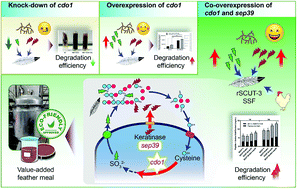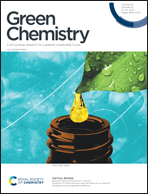Promotion of feather waste recycling by enhancing the reducing power and keratinase activity of Streptomyces sp. SCUT-3†
Abstract
As a potential renewable and nitrogen-rich resource, millions of tons of feather waste are generated from poultry farming and this has been steadily increasing. Bioconversion is the most promising low-cost and environmentally benign recycling method, while the efficiency of the isolated natural feather degrading bacteria (FDB) cannot satisfy the requirements of industrial utilization. The process of bacterial degradation of feathers not only requires proteases but also involves complex reduction mechanisms that have not yet been revealed. Previous heterologous expression of keratinase genes in non-FDB hosts achieved only very limited success. In this study, the mechanism of sulfite production via cysteine dioxygenase (CDO1) oxidation was first identified in Streptomyces sp. SCUT-3, which is important for feather disulfide bond reduction. The knockdown of cdo1 significantly decreased the sulfite production (from 38.5 to 22.5 mg L−1) and feather degradation rate (from 45.7% to 39.5%) of SCUT-3 in 5% chicken feather medium (CFM) culture. The overexpression of cdo1 increased bacterial single-cell sulfite production and feather protein conversion efficiency by 3.8 and 2.5 fold, respectively, on day 2 in 5% CFM. On this basis, a new strategy is proposed for increasing feather degradation efficiency by enhancing the reducing power and keratinase activity of FDB according to their own feather degradation mechanism. Thus, the co-overexpression of CDO1 and protease Sep39 successfully increased SCUT-3's feather protein conversion efficiency (42.5% higher than the wild-type) on day 2 in 5% CFM culture. With the co-overexpression strain SCUT-Ocdo1-sep39, 57.5% of proteins in feathers were converted to soluble peptides and free amino acids (0.20 g and 0.29 g g−1 feather, respectively) by solid-state fermentation in 6 d, which was 28.6% higher than that obtained for wild-type SCUT-3. The method developed herein exhibits a much higher economic benefit and a lower ecological footprint than previously reported feather-processing methods and is powerful for industrial recycling of feather waste. This study also elucidates FDB's disulfide bond mechanism and provides a reference for further genetic modification of FDB.



 Please wait while we load your content...
Please wait while we load your content...